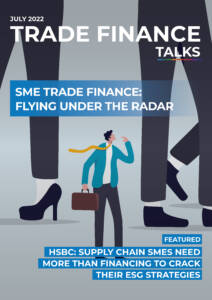Listen to this podcast on Spotify, Apple Podcasts, Podbean, Podtail, ListenNotes, TuneIn
Managing risk within lending and underwriting is essential during uncertain times.
Given the critical role credit insurance and surety plays within trade and export finance, TFG spoke with Tinubu about the role of artificial intelligence (AI) and distributed ledger technologies (DLT) in future-proofing the industry.
The period between the crash of March 2020 and the second quarter of 2022 has been exceptionally volatile and filled with uncertainty.
Although the full economic fallout of COVID was not immediately apparent, it has finally started to trickle down and is having a real impact on the world of trade and finance in the form of supply chain disruption, volatility in global markets, inflation, and liquidity issues.
For many institutions, particularly those involved in credit lending or insurance, navigating a black swan event on this scale and magnitude has highlighted the need to find new models for both measuring and handling risk.
Up until now, digitisation was mainly seen as a tool for improving client relationships, enhancing sustainability credentials, and developing more efficient underwriting systems (through processes like risk-adjusted pricing automation and better risk management).
More recently though, banks, trade financiers, and insurers are seeing the value of using technology to enhance their resilience, particularly in areas such as risk management.
Coupled with that, many of these organisations have also been facing increasing pressure, both from corporate clients wanting more transparency around financial services and as a result of external competition from new digital trade platforms.
This has led to several trends that threaten to disrupt the status quo within the financial system, including the use of AI, DLT, and quantum computing to formulate new distribution models, financial products and services that are also more sustainable.

The role of AI, DLT, and quantum computing
So, how exactly could these new technologies shape the future of trade finance and improve risk management?
According to Tinubu’s Sophie Riottot, AI is already being used by many insurance companies to set credit limits – a trend she believes will accelerate as more applications are found for it in areas like credit scoring and country risk assessment.
“We also believe that AI enables businesses to anticipate low signals and we consider AI a long-term driver of predictive intelligence at a macro and microeconomic levels,” Riottot said.
“As a result, we expect it will enable the industry to take on more risk from automated underwriting processes and better risk selection processes.”
In addition, as the efficacy and benefits of open-source technology become more widely understood and incorporated into various business scenarios, applications for finance and insurance will multiply.
Currently, they offer the best means of sharing data securely and reducing fraud.
Despite popular sentiment, use cases have been well-tested and documented.
“Blockchain is neither a technology challenge nor questionable in terms of use cases: trade is all about sharing data in a secure and consistent manner while reducing fraud and improving transparency,” Riottot said.
“At Tinubu, we have demonstrated the feasibility of business scenarios in the blockchain and their execution on a DLT for the management of construction projects.”
Riottot is also excited about the potential of quantum computing to push the frontiers of model predicting for insurance professionals like actuaries with faster processing of data through unlimited hardware, enabling models to update and evolve in real-time.
These innovations have all become possible thanks to an explosion around the mainstream adoption of things like cryptocurrencies, as well as the amount of data being generated by different systems and platforms.

Long-term adoption: only time will tell
Whether these practically untested technologies end up succeeding depends largely on if the entire financial ecosystem evolving sufficiently, to integrate them.
For Riottot, these revolve around two main challenges for the industry:
The first is developing and agreeing on common data management standards that improve industry-wide communication, security, and systems integration between organisations.
The second is a need for more transparency and data availability to facilitate open-source development through cooperation and information sharing.
For Tinubu, innovation and cutting-edge technology development is not the issue – it is more a question of cooperation to unlock long-term sustainable growth of digitised trade finance and related credit insurance.
Through their R&D innovation lab, Tinubu has been focusing on how to solve this issue and find ways to get companies to exchange information with each other more efficiently, even if they operate on different systems.
For example, their use in the so-called ‘trade finance platforms’ rests on their ability to generate useful APIs.
This podcast was recorded at ExCred International.
Read the latest issue of Trade Finance Talks, July 2022






































